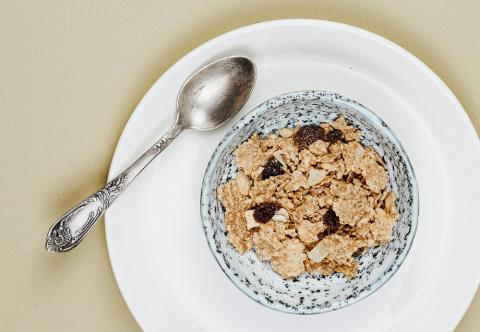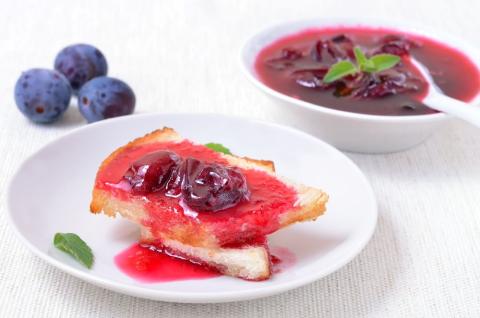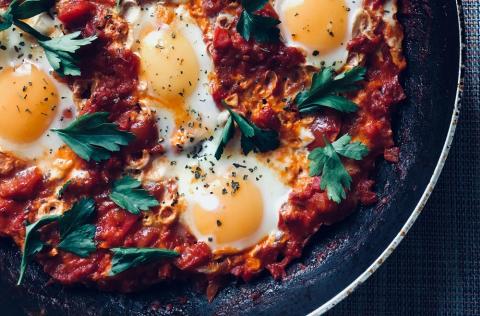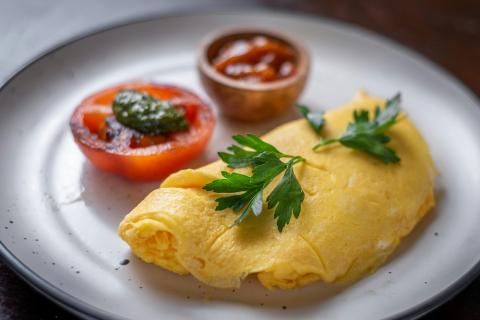- 8 Eggs
- 4 Medium Slices Wholemeal Bread
- 4 Teaspoons (12g) Vegetable Oil
- 1 Pinch Black Pepper to taste
- 4 Teaspoons (20g) Low Fat Spread
Ingredients
Allergy Disclaimer
Always check the label of each ingredient for allergy warnings.
Method
- Add 1 teaspoon of oil to the frying pan and heat to medium hot.
- Crack 2 eggs into a bowl or cup. Beat them together with the black pepper then pour into the frying pan.
- Stir with a fork until the egg starts to set then cook until it is set.
- Fold the omelette over in the pan. Spread a slice of toast with 1 teaspoon of low fat spread and serve the omelette on top.
- Repeat the steps above to make another 3 omelettes.
Cost Saver Tips
Serve with salad for a light meal option and try adding some boiled potatoes for a main meal.
Tips for Kids
Choose their favourite fillings to make this omelette super tasty – such as cheese, ham, smoked salmon, peppers, mushrooms or sweetcorn. If they aren't keen on wholemeal toast, try 50:50.
Nutritional Information
Based on a single serving of 140g (% of an adult's reference intake)
Energy
286 kcals ( 14 %)
1,199 kJ ( 14 %)
Fat
3.6 g ( 18 %)
Saturates
19.9 g ( %)
Sugar
1.4 g ( 2 %)
Salt
0.9 g ( 15 %)
Detailed nutritional information
| Per 100g | Per 140g serving | |
|---|---|---|
| Energy Kcals | 204 | 286 |
| Energy Kj | 857 | 1,199 |
| Protein | 12.3 g | 17.2 g |
| Total Fat | g | g |
| Saturated Fat | 2.6 g | 3.6 g |
| Carbohydrates | 14.2 g | 19.9 g |
| Total Sugars | 1 g | 1.4 g |
| NSP Fibre | 2.4 g | 3.4 g |
| Sodium | 271 mg | 379 mg |
| Salt | 0.7 g | 0.9 g |
Find out about nutritional labelling
Nutrition labels on the front of packaging
- Most of the big supermarkets and many food manufacturers display nutritional information on the front of pre-packed food.
- Front of pack nutrition labels provide information on the number of grams of fat, saturated fat, sugars and salt and the amount of energy (in kJ and kcal) in a serving or portion of a recipe.
- The labels also include information about reference intakes (expressed as a percentage) which are guidelines about the approximate amount of particular nutrients and energy required for a healthy diet.
- The colour coding tells you at a glance if the food has high (red), medium (amber) or low (green) amounts of fat, saturated fat, sugars and salt.
- The more greens on the label, the healthier the choice
- Amber means neither high nor low, so you can eat foods with all or mostly ambers on the label most of the time.
- Reds on the label means the food is high in that nutrient and these are the foods we should cut down on. Try to eat these foods less often and in small amounts.
Food shopping tips
If you’re trying to decide which product to choose, check to see if there's a nutrition label on the front of the pack. This will help you to quickly assess how your choices stack up. You will often find a mixture of red, amber and green colour coding for the nutrients. So when you're choosing between similar products, try to go for more greens and ambers and fewer reds if you want to make a healthier choice.
 Activities & Play
Activities & Play Behaviour
Behaviour Childcare
Childcare Development & Growing Up
Development & Growing Up Family, Friends & Relationships
Family, Friends & Relationships Feeding Your Baby
Feeding Your Baby Food & Eating
Food & Eating Health & Safety
Health & Safety Mental Health & Wellbeing
Mental Health & Wellbeing Money & Work
Money & Work Online Behaviour & Safety
Online Behaviour & Safety Pregnancy & First Days
Pregnancy & First Days School & Education
School & Education Sleep
Sleep



















